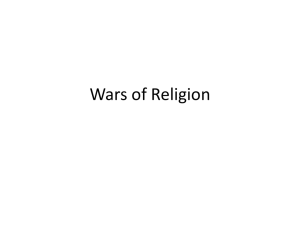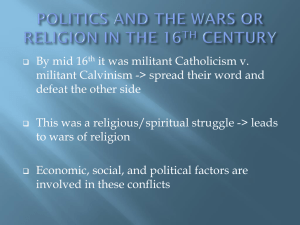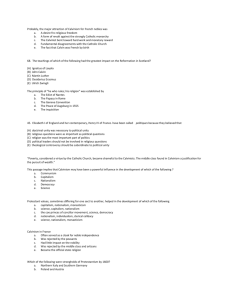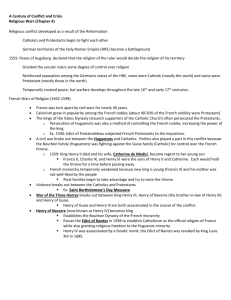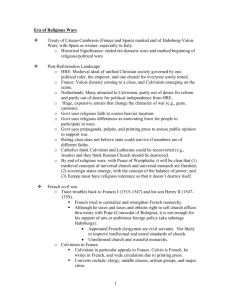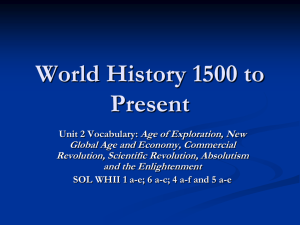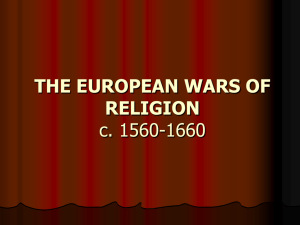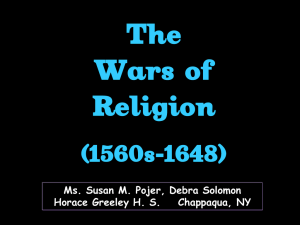wars of religion
advertisement
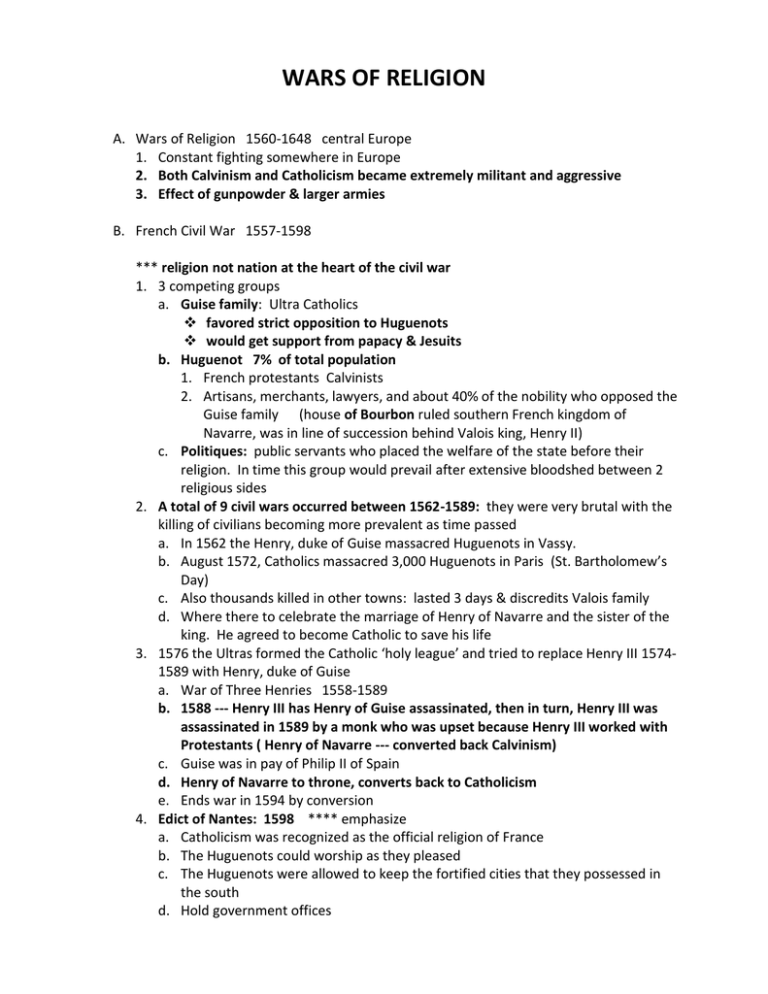
WARS OF RELIGION A. Wars of Religion 1560-1648 central Europe 1. Constant fighting somewhere in Europe 2. Both Calvinism and Catholicism became extremely militant and aggressive 3. Effect of gunpowder & larger armies B. French Civil War 1557-1598 *** religion not nation at the heart of the civil war 1. 3 competing groups a. Guise family: Ultra Catholics favored strict opposition to Huguenots would get support from papacy & Jesuits b. Huguenot 7% of total population 1. French protestants Calvinists 2. Artisans, merchants, lawyers, and about 40% of the nobility who opposed the Guise family (house of Bourbon ruled southern French kingdom of Navarre, was in line of succession behind Valois king, Henry II) c. Politiques: public servants who placed the welfare of the state before their religion. In time this group would prevail after extensive bloodshed between 2 religious sides 2. A total of 9 civil wars occurred between 1562-1589: they were very brutal with the killing of civilians becoming more prevalent as time passed a. In 1562 the Henry, duke of Guise massacred Huguenots in Vassy. b. August 1572, Catholics massacred 3,000 Huguenots in Paris (St. Bartholomew’s Day) c. Also thousands killed in other towns: lasted 3 days & discredits Valois family d. Where there to celebrate the marriage of Henry of Navarre and the sister of the king. He agreed to become Catholic to save his life 3. 1576 the Ultras formed the Catholic ‘holy league’ and tried to replace Henry III 15741589 with Henry, duke of Guise a. War of Three Henries 1558-1589 b. 1588 --- Henry III has Henry of Guise assassinated, then in turn, Henry III was assassinated in 1589 by a monk who was upset because Henry III worked with Protestants ( Henry of Navarre --- converted back Calvinism) c. Guise was in pay of Philip II of Spain d. Henry of Navarre to throne, converts back to Catholicism e. Ends war in 1594 by conversion 4. Edict of Nantes: 1598 **** emphasize a. Catholicism was recognized as the official religion of France b. The Huguenots could worship as they pleased c. The Huguenots were allowed to keep the fortified cities that they possessed in the south d. Hold government offices *** principle of religious toleration --- by political necessity not conviction C. Spain 1. Charles V a. While dispersed, the land of the Holy Roman Empire encircled France b. Led the fight against the Ottoman Empire c. 2. Phillip II 1556-1598 *** advocate of militant Catholicism *** age of Spanish greatness, politically & culturally a. Goals: 1. Consolidation & secure the lands that he inherited from his father 2. Creation of a strong national government through the use of military force and the Inquisition 3. Led Christian forces which defeated the Ottoman fleet at the Battle of Lecanto in 1571, off the coast of Greece Champion of Catholicism but had defeats as well (Netherlands & England) b. Problems: 1. He was always short of funds even with the tons of gold and silver that was pouring into Spain from the new world. This source never amounted to more than 20% of the budget and it led to an inflated currency. He found a short term solution by borrowing huge sums of money and then repudiating the debts seven years later. (would affect textile production & agriculture & brought increase in taxes) 2. ** 2/3 of state income went to pay off debts. The attempt to make Spain a great power led to its decline after Philip’s reign 3. Reformation with its confusing welter of competing sects 4. France supported his opponents even if they were protestant 5. Britain was waging an undeclared war against Spain in Latin America c. Netherlands 1. One of HRE’s most lucrative territories --- trade & textile industry 2. 17 provinces in what is today Belgium, Netherlands, & Luxembourg a. Seven northern provinces were Protestant, speaking Dutch & German b. Ten southern provinces were Catholic, speaking French & Flemish. More supportive of the French than the Spanish 3. 1566 --- Protestants began to destroy Catholic churches and religious statues --- religion became major catalyst for rebellion when Philip attempted to crush Calvinism --- nobles involved in rebellion 4. Philip sent Duke of Alva with 10,000 soldiers (Spanish & Italian troops) a. Alva levied a permanent 10% sales tax, most of which was sent to Spain Alva set up the Council of Troubles (Dutch called it Council of blood) 1. Reign of terror ---Alva was fired in 1573 5. The southern provinces established the Catholic Union 6. The northern provinces established the Union of Utrecht a. eventually became the Dutch Republic b. Elizabeth I supported the northern provinces. 7. Netherlands divided along religious, geographical, political lines D. Queen Elizabeth 1. Religious policy based on moderation & compromise a. To prevent England from being torn apart b. Catholic legislation repealed: Act of Supremacy, Act of Uniformity 2. Mary, Queen of Scots cousin & Catholic a. Held her under house arrest from fleeing Scotland b. After numerous plots on Elizabeth’s life, 1587 had her beheaded 3. Puritans word came about in 1564 when members of church,, inspired by Calvinists wanted to remove any trace of Catholicism from Church of England a. Kept in check during her reign 4. Foreign policy a. Sea Dogs --- Francis Drake b. Aid to French Huguenots and Dutch Calvinists E. The Spanish Armada 1. Philip was engaged to Elizabeth, who managed to put him off for fifteen years 2. Philip finally decided to invade England for a variety of reasons a. Restore England to the Catholic Church ***overthrow of heresy b. End the activities of the Sea Dogs (English) and Sea Beggars (Dutch) c. Cut off the financial support for the Netherlands Rebellion d. Complete the encirclement of France e. Defeat a psychological blow to the Spaniards F. Outcomes of the Reformation 1. Religious pluralism and personal liberty was more widespread than before. It was not religious toleration 2. New interest in education 3. Calvinism promoted democracy and the rise of personal liberties 4. Greater impact on social and economic life. By taking wealth away from the church and redirecting it toward education and social welfare 5. Use of the printing press for mass distribution of ideas 6. States became stronger at the expense of the church and the nobility 7. Wars increased in frequency and violence 8. Decline in the power of the papacy 9. Decline of the HRE
